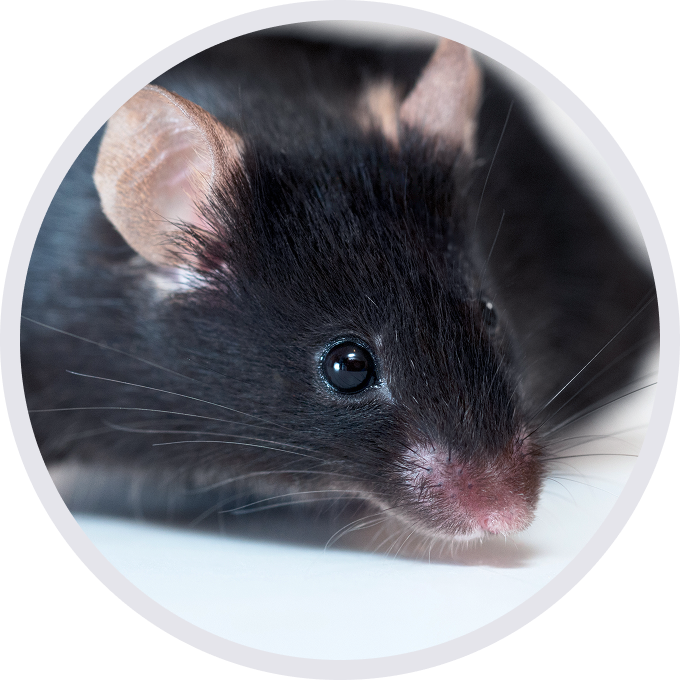
C57BL/6-Gt(ROSA)26Sortm2(LPA)Bcgen Apobtm1(APOB)Bcgen/Bcgen • 113427
このページで
Gene targeting strategy for B-hLPA/hAPOB mice. The full coding sequences of human Lpa gene that is driven by ALB promoter was inserted into the Gt(ROSA)26Sor gene locus site. And there’s no LPA gene in the mouse genome sequence.The exons 1-29 of mouse Apob gene that encode the whole molecule (ATG to STOP codon), including 5’UTR and 3’UTR were replaced by human counterparts in B-hAPOB mice. The human APOB expression is driven by human APOB promoter, while mouse Apob gene transcription and translation will be disrupted. B-hLPA/hAPOB mice were obtained by mating B-hLPA mice (112723) and B-hAPOB mice (112951).
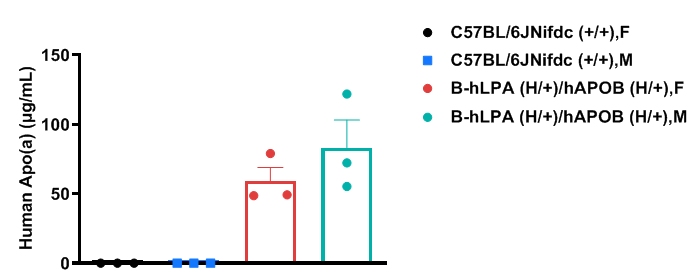
Strain-specific Apo(a) expression analysis in wild-type C57BL/6JNifdc mice and heterozygous humanized B-hLPA/hAPOB mice by ELISA. Serum was collected from wild-type C57BL/6JNifdc mice (+/+) and heterozygous B-hLPA/hAPOB mice (H/+, H/+) (n=3, 6-week-old). The expression level of human Apo(a) was analyzed by ELISA (Abcam, ab212165). Human Apo(a) was exclusively detectable in heterozygous B-hLPA/hAPOB mice, but not in wild-type C57BL/6JNifdc mice. Values are expressed as mean ± SEM.

Strain-specific APOB expression analysis in wild-type C57BL/6JNifdc mice and homozygous humanized B-hLPA/hAPOB mice by ELISA. Serum was collected from wild-type C57BL/6JNidfc mice (+/+) and homozygous B-hLPA/hAPOB mice (H/H) (n=3, 6 weeks old, female; n=3, 6 weeks old, male). Expression level mouse and human APOB were analyzed by ELISA (Mouse: Abcam, ab230932; Human: ab108807). Human APOB was exclusively detectable in homozygous B-hLPA/hAPOB mice, but not in wild-type C57BL/6JNidfc mice. Values are expressed as mean ± SEM.
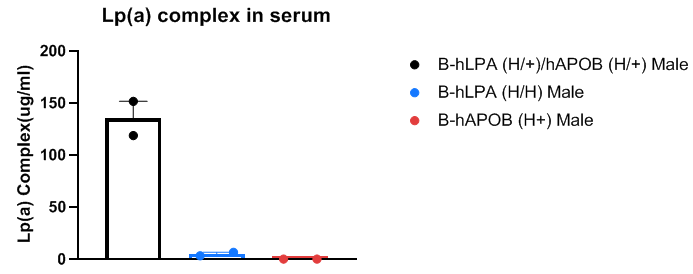
Strain-specific Lp(a) complex expression analysis in heterozygous humanized B-hLPA/hAPOB mice by ELISA. Serum was collected from heterozygous B-hLPA/hAPOB mice (H/+) (n=2, 11 weeks old, male), heterozygous B-hAPOB mice (H/+) (n=2, 11 weeks old, male), and homozygous B-hLPA mice (H/H) (n=2, 8 weeks old, male). Lp(a) complex can be detected in heterozygous humanized B-hLPA/hAPOB mice, but not in homozygous B-hLPA mice and heterozygous B-hAPOB mice. Note: Data was shared from a client. Values are expressed as mean ± SEM.

Strain-specific Lp(a) complex expression analysis in homozygous humanized B-hLPA/hAPOB mice by ELISA. Serum was collected from homozygous B-hLPA/hAPOB mice (H/H) (n=3, 8 weeks old, male and female) to measure Lp(a) complex. Values are expressed as mean ± SEM.
Note: Data was shared from another client.

Changes of plasma Lp(a) levels in B-hLPA/hAPOB mice in response to muvalapin. B-hLPA/hAPOB mice were randomly divided into three groups (male, 6 weeks old, n=3). Muvalapin and vehicle (1% hydroxyethyl cellulose (HEC), 0.25% Tween-80) were administered to the mice individually. Plasma of B-hLPA/hAPOB mice was collected to measure the Lp(a) complex (Capture in ab212165 combined with ab27622 as detection antibody). (A) The schematic diagram of experimental processing. (B) % Mean change of Lp(a) complex relative to baseline after administration.

Changes of plasma Lp(a) and Apo(a) levels in B-hLPA/hAPOB mice in response to siRNA drug target LPA. B-hLPA/hAPOB mice were randomly divided into two groups (male, 6 weeks old). Human siRNA drug (Olpasiran analog, provided by the client) and saline were administered to the mice individually. Plasma of B-hLPA/hAPOB mice were collected to measure the Lp(a) complex (Capture in ab212165 combined with ab27622 as detection antibody) and human Apo(a) (Abcam, ab212165). (A) The schematic diagram of experimental processing. (B) % Mean change of Lp(a) complex relative to baseline after administration of a single dose (C) Human Apo(a) concentration after administration of a single dose. (D) % Mean change of human Apo(a) relative to baseline after administration of a single dose. Olpasiran analog reduced the Lp(a) and Apo(a) after administration of a single dose.
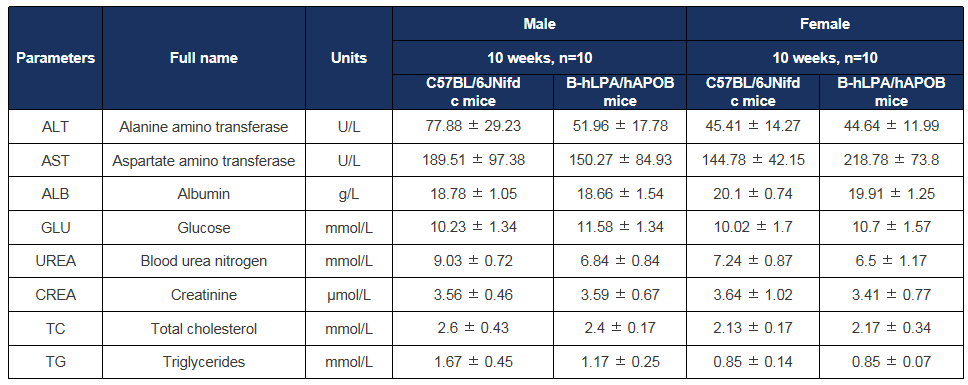
Biochemical test of B-hLPA/hAPOB mice. Values are expressed as mean ± SD.
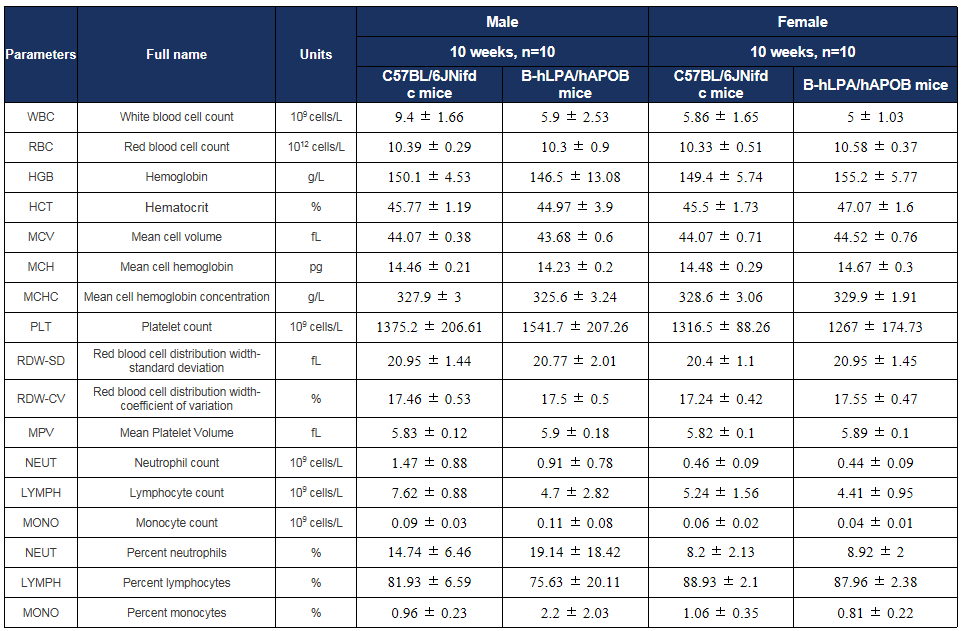
Complete blood count (CBC) of B-hLPA/hAPOB mice. Values are expressed as mean ± SD.
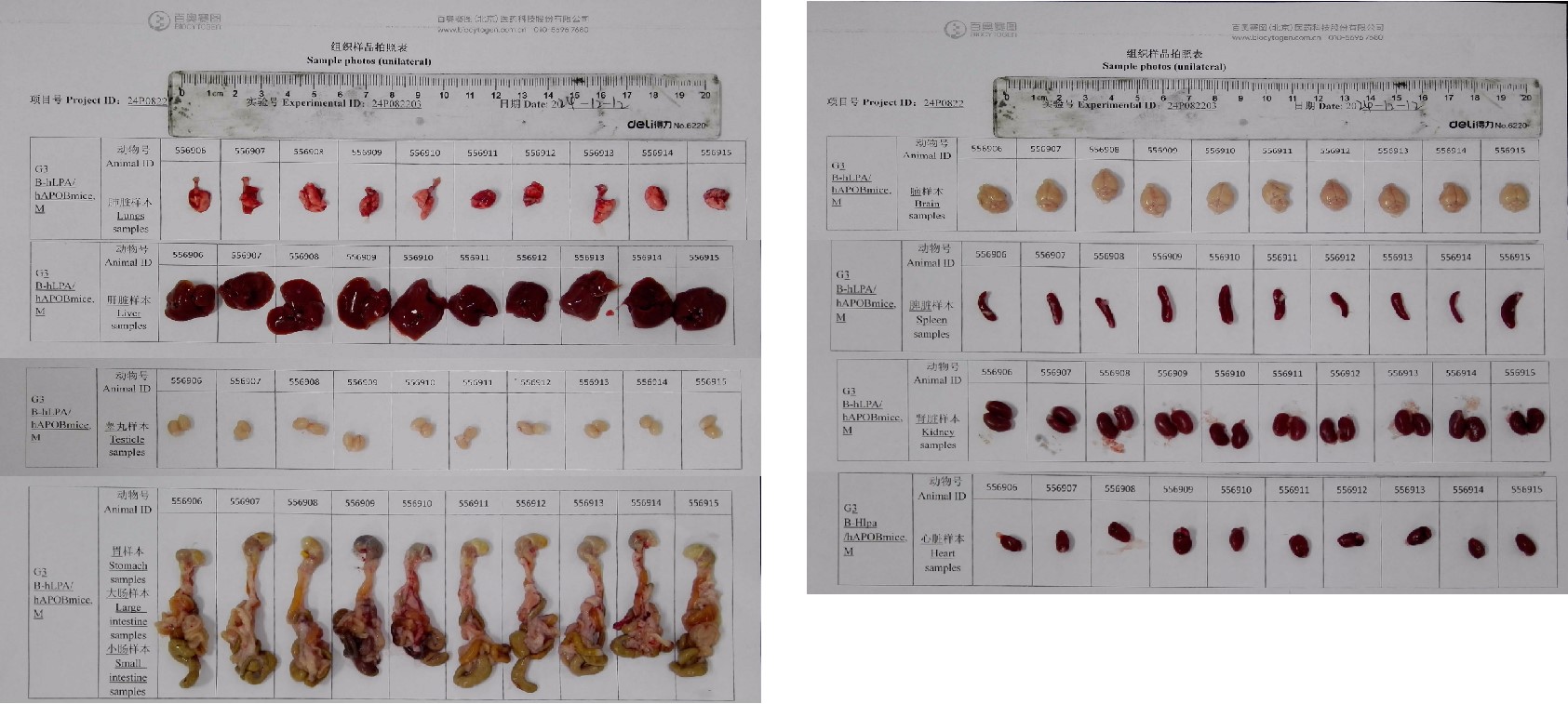
The organs of male B-hLPA/hAPOB mice (10-week-old, n=10).
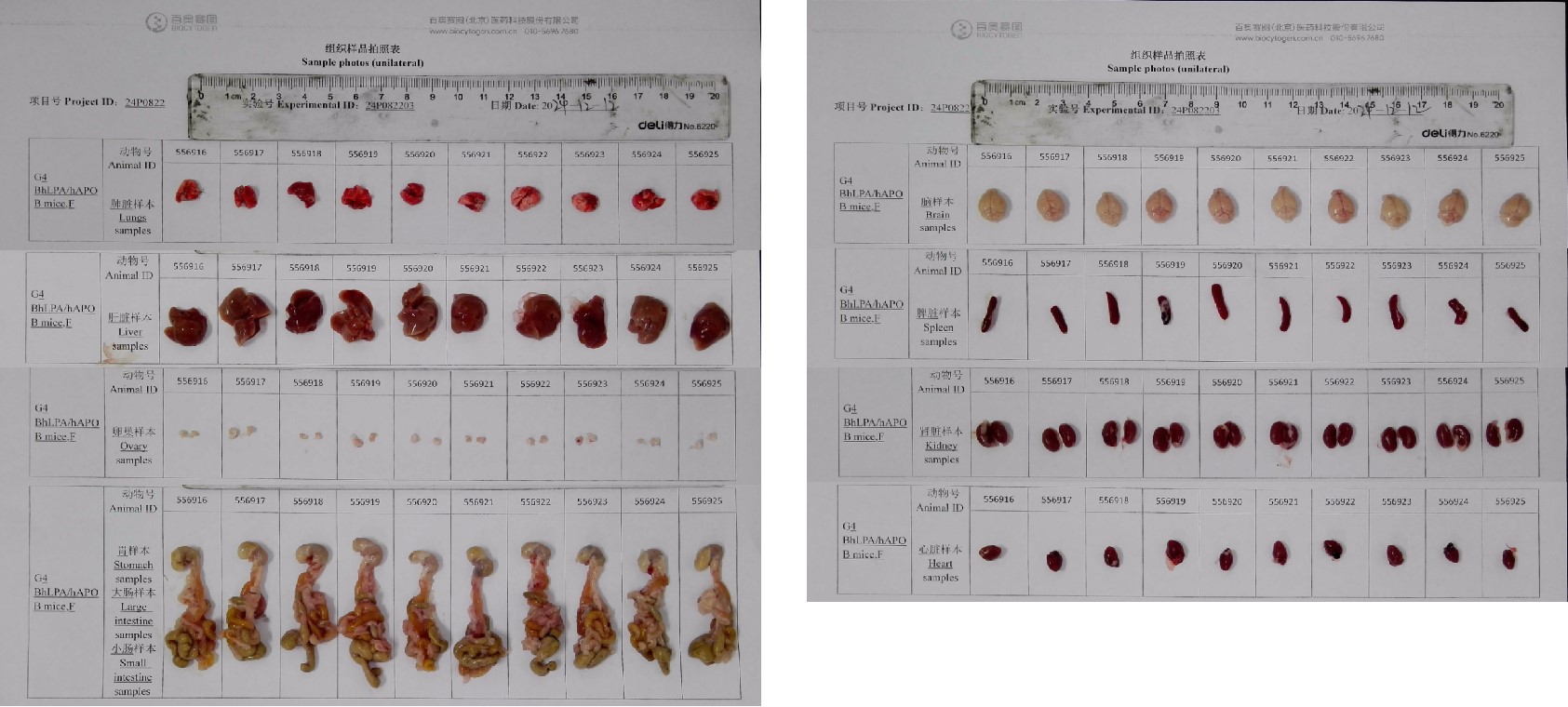
The organs of female B-hLPA/hAPOB mic (10-week-old, n=10).
C57BL/6JNifdc pathological evaluation of various tissues and organs
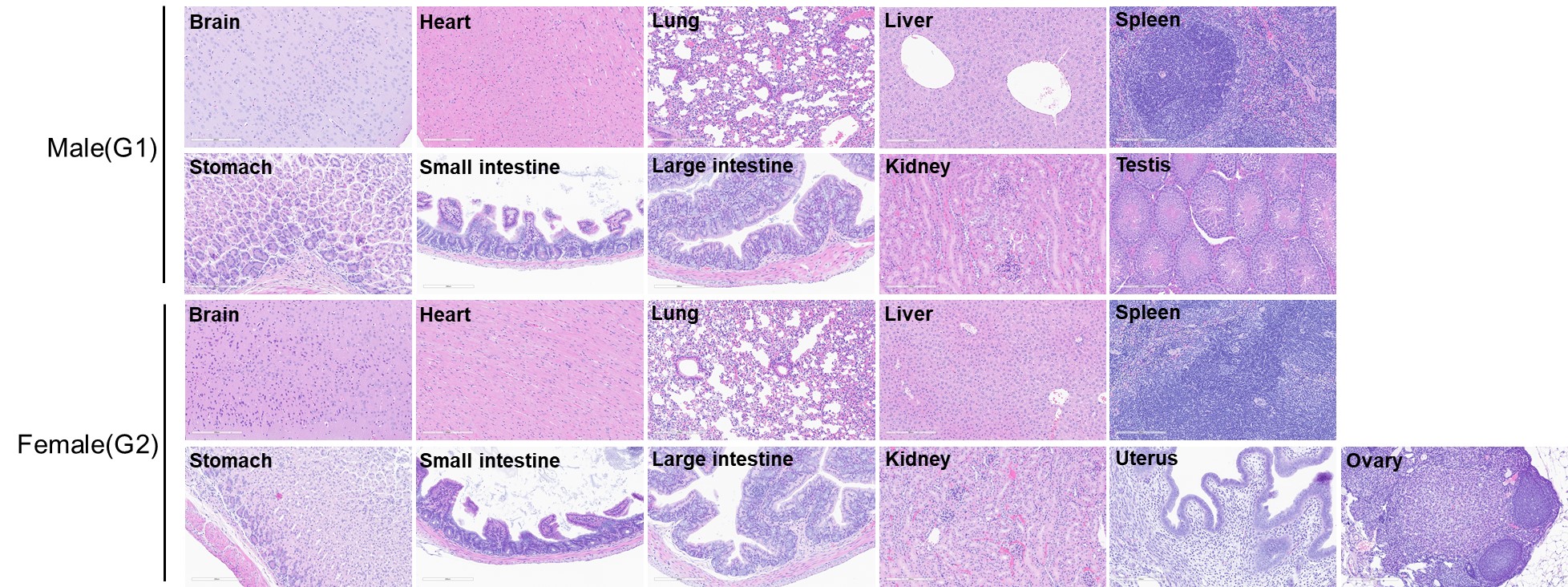
B-hLPA/hAPOB mice pathological evaluation of various tissues and organs
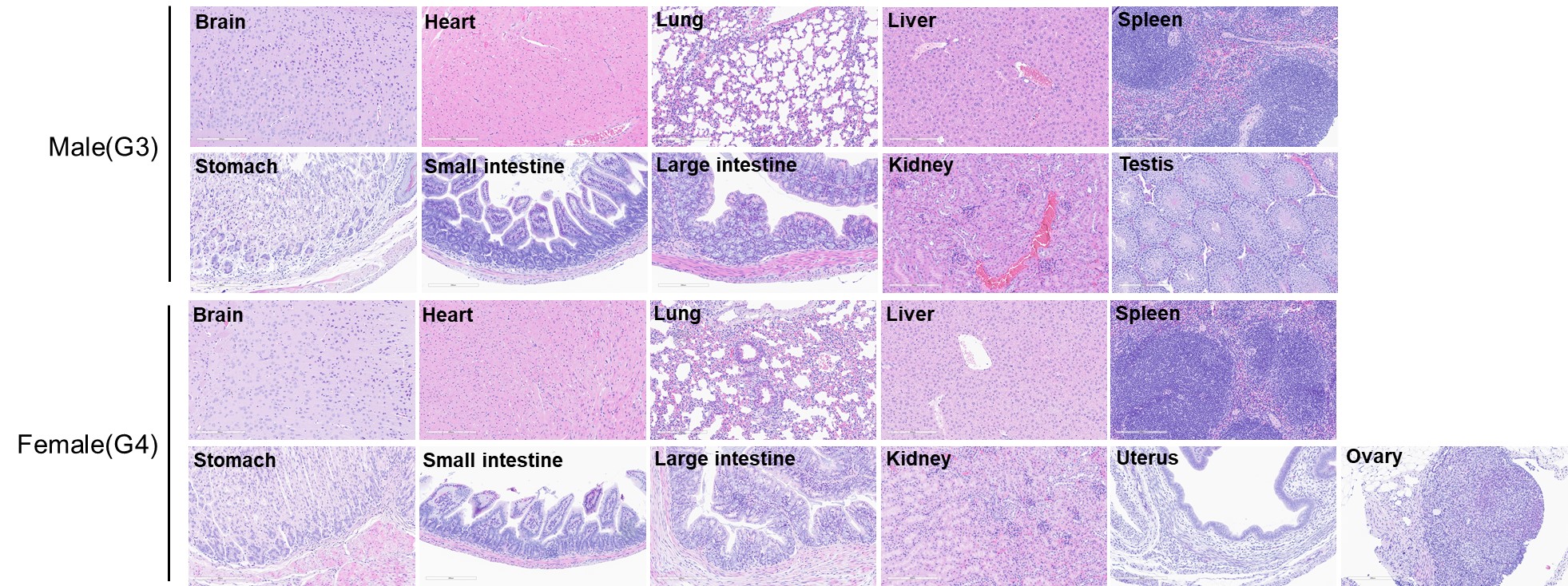
The pathological results of major tissues and organs showed no significant difference from those of wild-type C57BL/6 mice.